Related Research Articles

An electric guitar is a guitar that requires external amplification in order to be heard at typical performance volumes, unlike a standard acoustic guitar. It uses one or more pickups to convert the vibration of its strings into electrical signals, which ultimately are reproduced as sound by loudspeakers. The sound is sometimes shaped or electronically altered to achieve different timbres or tonal qualities from that of an acoustic guitar via amplifier settings or knobs on the guitar. Often, this is done through the use of effects such as reverb, distortion and "overdrive"; the latter is considered to be a key element of electric blues guitar music and jazz, rock and heavy-metal guitar-playing. Designs also exist combining attributes of the electric and acoustic guitars: the semi-acoustic and acoustic-electric guitars.

C.F. Martin & Company is an American guitar manufacturer established in 1833 by Christian Frederick Martin. It is highly respected for its acoustic guitars and is a leading manufacturer of flat top guitars and ukuleles. The company has also made mandolins and tiples, as well as several models of electric guitars and electric basses, although none of these other instruments are still in production.

Heritage Guitar is an American musical instrument manufacturer company based in Kalamazoo, Michigan, United States. The company produces a range of electric guitars, including hollow-body models.
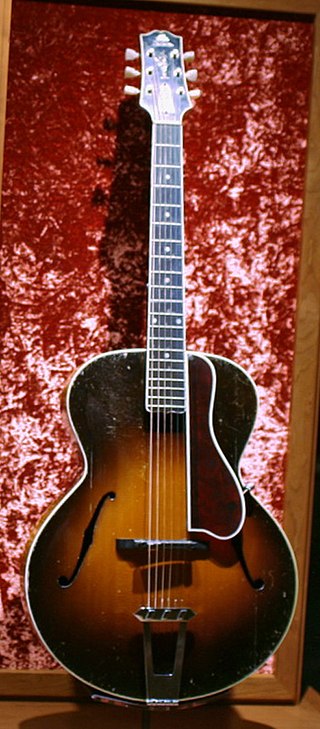
The Gibson L-5 is a hollow body guitar first produced in 1923 by the Gibson Guitar Corporation, then of Kalamazoo, Michigan. The first guitar to feature F-holes, the L-5 was designed under the direction of acoustical engineer and designer Lloyd Loar, and has been in production ever since. It was considered the premier guitar of the company during the big band era. It was originally offered as an acoustic instrument, with semi-acoustic models not made available until the 1940s.
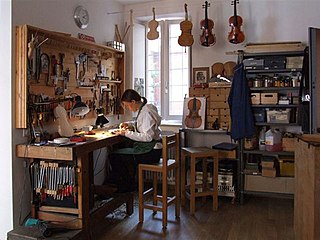
A luthier is a craftsperson who builds or repairs string instruments.

Epiphone is an American musical instrument brand that traces its roots to a musical instrument manufacturing business founded in 1873 by Anastasios Stathopoulos in İzmir, Ottoman Empire, and moved to New York City in 1908. After taking over his father's business, Epaminondas Stathopoulos named the company "Epiphone" as a combination of his own nickname "Epi" and the suffix "-phone" in 1928, the same year it began making guitars. From the 1930s through to the early 1950s, Epiphone produced a range of both acoustic and (later) electrified archtop guitars that rivalled those produced by Gibson and were the instruments of choice of many professionals; a smaller range of flat-top guitars were also produced, some designations of which were later continued during the Gibson-owned era for the company.

The Gibson EDS-1275 is a double neck Gibson electric guitar introduced in 1963 and still in production. Popularized and raised to iconic status by musicians such as John McLaughlin and Jimmy Page, it was called "the coolest guitar in rock".
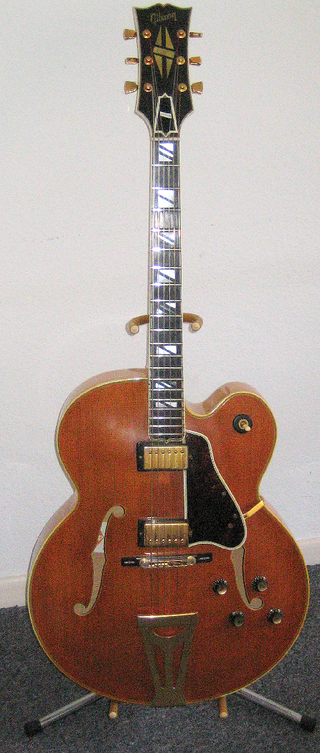
An archtop guitar is a hollow acoustic or semi-acoustic guitar with a full body and a distinctive arched top, whose sound is particularly popular with jazz, blues, and rockabilly players.

Lloyd Allayre Loar (1886–1943) was an American musician, instrument designer and sound engineer. He is best known for his design work with the Gibson Mandolin-Guitar Mfg. Co. Ltd. in the early 20th century, including the F-5 model mandolin and L-5 guitar. In his later years he worked on electric amplification of stringed instruments, and demonstrated them around the country. One example, played in public in 1938 was an electric viola that used electric coils beneath the bridge, with no back, able to "drown out the loudest trumpet."

Orville H. Gibson was an American luthier who founded the Gibson Guitar Company in Kalamazoo, Michigan in 1902, makers of guitars, mandolins and other instruments.
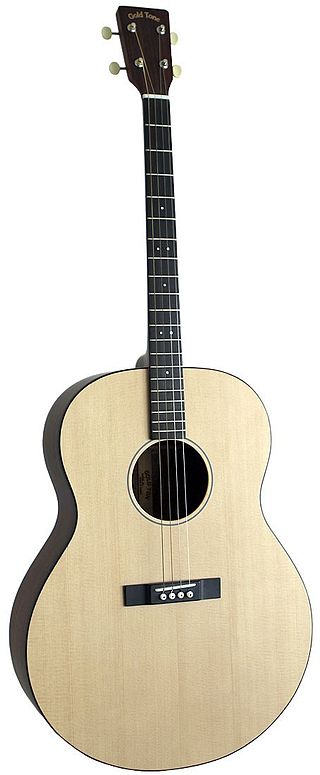
The tenor guitar or four-string guitar is a slightly smaller, four-string relative of the steel-string acoustic guitar or electric guitar. The instrument was initially developed in its acoustic form by Gibson and C.F. Martin so that players of the four-string tenor banjo could double on guitar.

The Gibson ES-175 (1949–2019) is a hollow body Jazz electric guitar manufactured by the Gibson Guitar Corporation. The ES-175 became one of Gibson's most popular guitar designs.

Kay Musical Instrument Company is an American musical instrument manufacturer established in 1931 by namesake Henry "Kay" Kuhrmeyer and based in Chicago, Illinois. It was formed when Kuhrmeyer bought out his financial backers in the instrument manufacturer Stromberg-Voisinet. They produced guitars, mandolins, banjos, ukuleles and were known for their use of lamination in the construction of arched top instruments.
Jazz guitarists are guitarists who play jazz using an approach to chords, melodies, and improvised solo lines which is called jazz guitar playing. The guitar has fulfilled the roles of accompanist and soloist in small and large ensembles and also as an unaccompanied solo instrument.
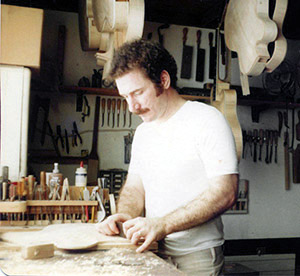
Robert Benedetto is an American luthier of archtop jazz guitars. In 1968, he made his first archtop guitar in New Jersey and has handcrafted nearly 850 musical instruments. His guitars appear on many recordings, videos, and TV and film soundtracks, and have been featured in books, magazines and museums.

The Gibson Super 400 is an archtop guitar. It is a highly influential guitar model that inspired many other master guitar builders. It was first sold in 1934 and named for its $400 price, like many Gibson guitars of that era.

Collings Guitars is an Austin, Texas–based stringed instrument manufacturer. The company was founded in 1973 by BillCollings. In addition to acoustic guitars, Collings Guitars manufactures electric guitars, archtop guitars, mandolins and ukuleles.
Jim Triggs is an American luthier, described as the "P.T. Barnum of guitar makers." He grew up in Kansas, where he taught himself how to build mandolins and violins. He began building guitars in the early 1980s, influenced by such luthiers as John D'Angelico, Elmer Stromberg, and Lloyd Loar, and went to work for Gibson Guitar Corporation in 1986 as one of the master luthiers in Gibson's custom shop. He is known mainly for archtop guitars and mandolins.

Ralph Oliver Patt was an American jazz guitarist who introduced major-thirds tuning. Patt's tuning simplified the learning of the fretboard and chords by beginners and improvisation by advanced guitarists. He invented major-thirds tuning under the inspiration of first the atonal music of Arnold Schoenberg and second the jazz of John Coltrane and Ornette Coleman.

The Gibson ES-350T is an electric guitar model from Gibson Guitar Corporation, released in 1955. The ES-350T is a further development of the Gibson ES-350 model from 1947 and as such has a completely hollow body. The unique feature of the Gibson ES-350T at the time of its market introduction was the reduced width of the rims. As a result, the guitar has a thinner body compared to instruments with a resonance body that is of full thickness. The ES-350T, together with its sister models Gibson ES-225 TDN and Gibson Byrdland, was one of the first models of the thinline guitar type.
References
- 1 2 3 4 5 6 Achard, Ken (1989). History and Development of the American Guitar. Bold Strummer. pp. 17–18. ISBN 978-0-933224-18-6.
- 1 2 Gruhn, George; Carter, Walter (1999). Gruhn's guide to vintage guitars: an identification guide for American fretted instruments. Hal Leonard. p. 562. ISBN 978-0-87930-422-5.
- ↑ Vose, Ken; Jean-Bart, Leslie (1998). Blue Guitar . Chronicle. p. 70. ISBN 978-0-8118-1912-1.
- 1 2 3 4 Bonds, Ray (2003). Illustrated Directory of Guitars. MBI. pp. 100–103. ISBN 978-0-7603-1561-3.
- ↑ Shaw, Robert; Tamborrino, Michael (2004). Classic Guitars. Pomegranate. p. 31. ISBN 978-0-7649-2888-8.
- 1 2 3 4 5 6 7 8 Gruhn, George; Walter Carter (October 2009). "The Stromberg G-5". Vintage Guitar . pp. 34, 106.
- ↑ Shaw, Robert; Tamborrino, Michael (2004). Classic Guitars. Pomegranate. p. 25. ISBN 978-0-7649-2888-8.
- 1 2 Lichens, Jim (2002). Barry Galbraith Guitar Solos: Thirteen Standards. Mel Bay. p. 53. ISBN 978-0-7866-6508-2.
- 1 2 Cusic, Don (2003). It's the cowboy way!: the amazing true adventures of Riders in the Sky. UP of Kentucky. p. 235. ISBN 978-0-8131-2284-7.